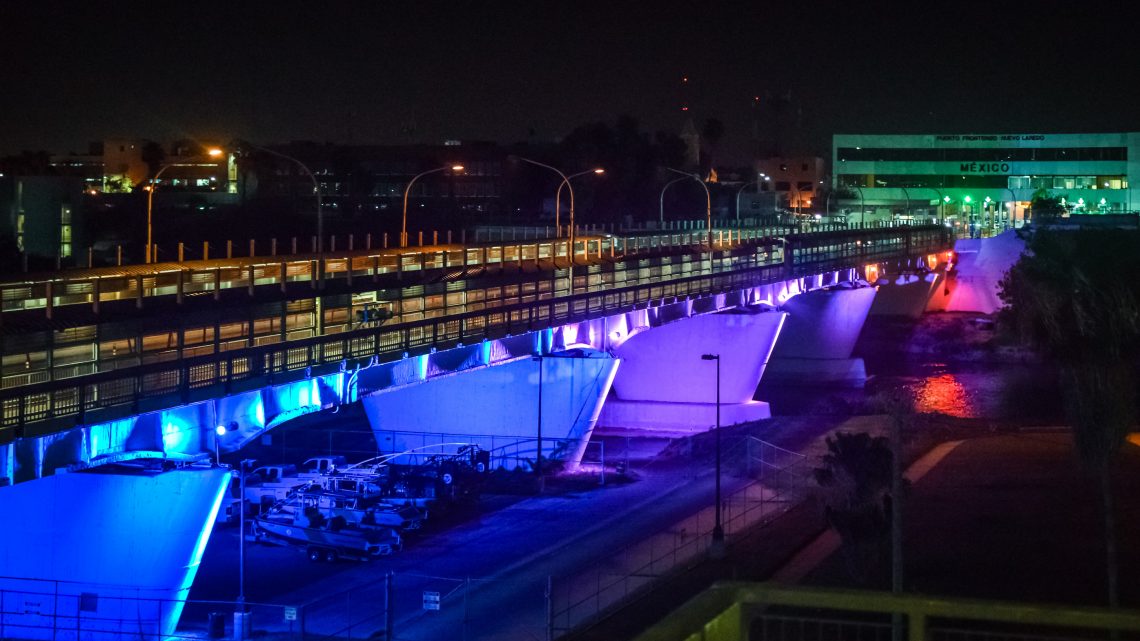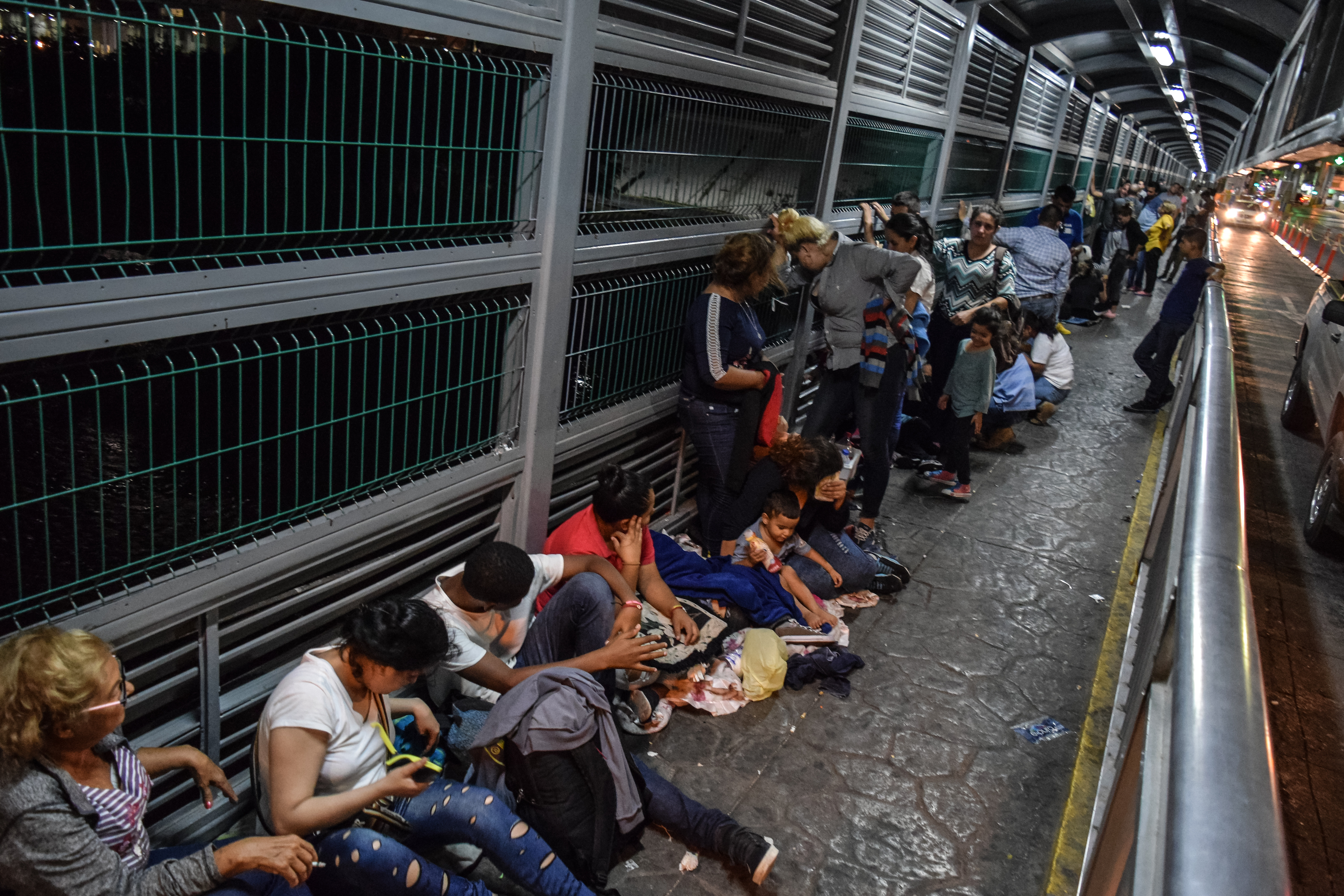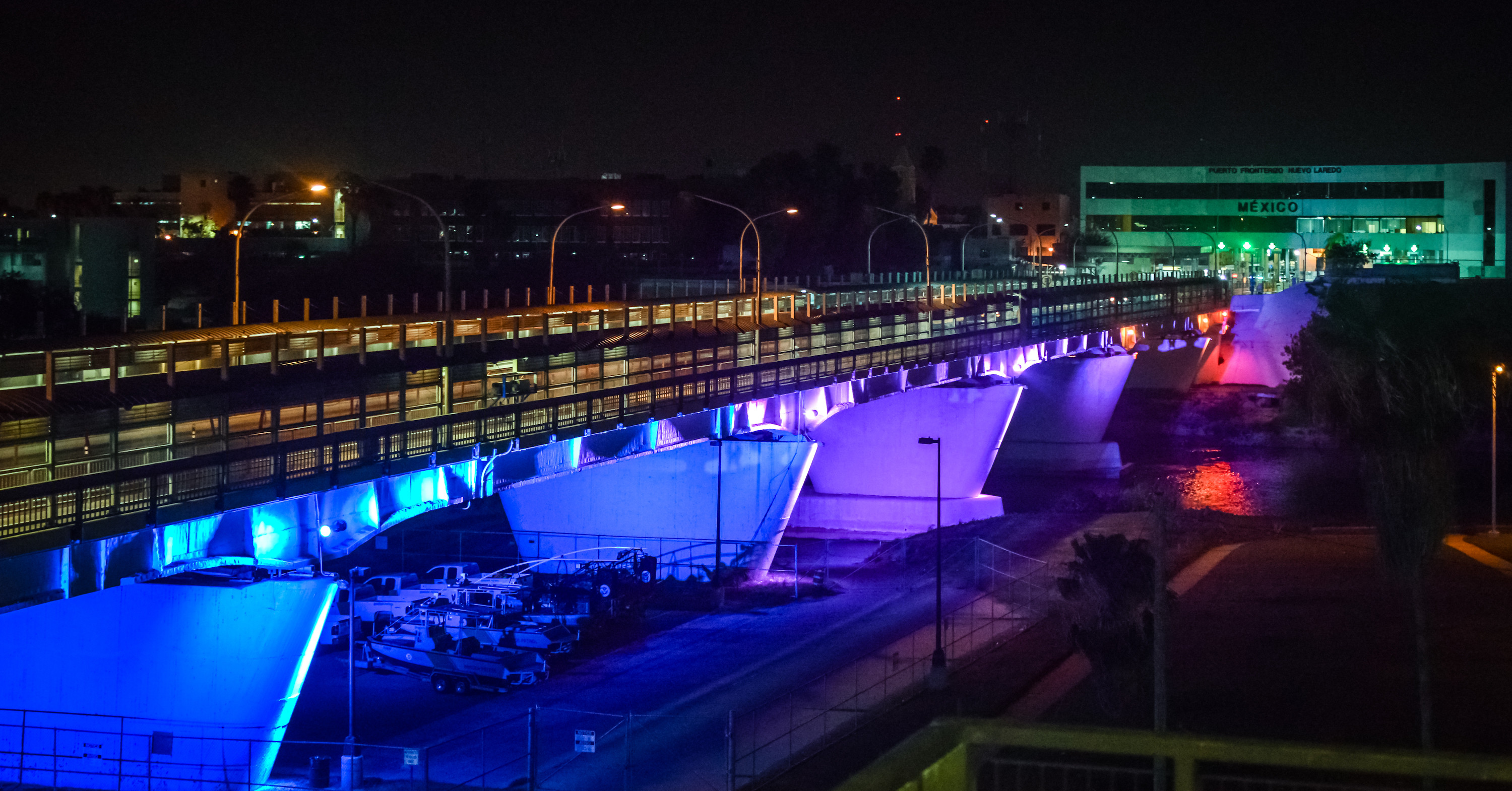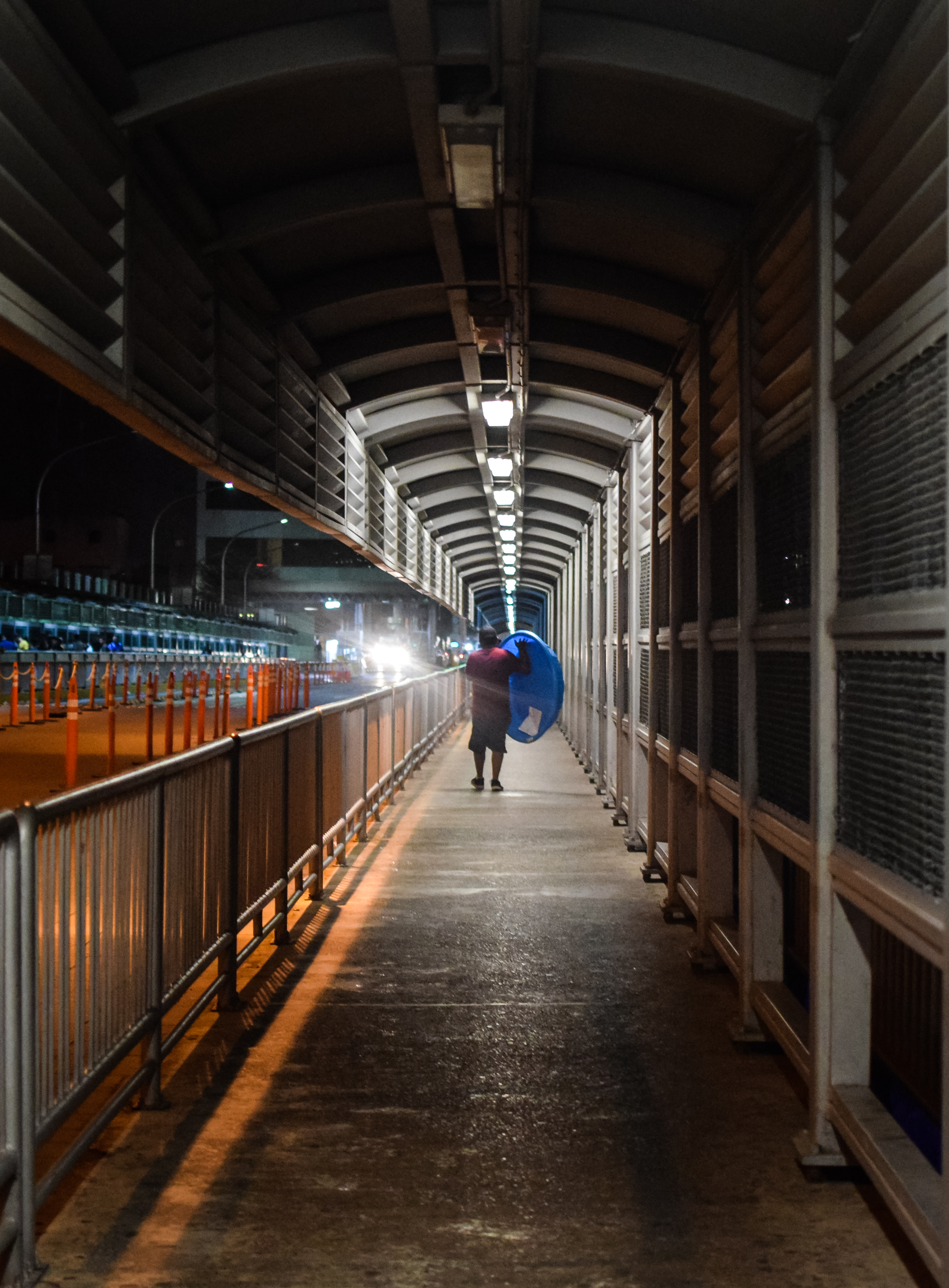
The Horrible Conditions Endured by Migrants Hoping to Enter the US Legally
July 3, 2018After spending 28 hours with her five-year-old twins on the Nuevo Laredo International Bridge, Jesenia was only halfway through the line of 70 people waiting to seek asylum in the United States. The group alternately stood, sat, and curled up on the hot stone ground in the 97-degree heat on the Mexican side of the overpass arching across the Rio Grande River—with no indication of when, or if, US officials would hear their pleas.
“They called up about four people this morning, and that’s it,” Jesenia, a 24-year-old El Salvadorian, told me last Thursday evening, as her son slumbered on the floor and her daughter grabbed onto her leg. (Like others I spoke to, she would not give her last name.) Thick bags beneath her eyes made it obvious Jesenia had not slept in days, but she would stay here as long as it took to speak with a US immigration agent: If she returned to her country she was certain that her husband—who had shut her in their house the past six years, beating her and threatening her and her children—would kill her.
“All I hope is that they let us pass,” she said, gazing through the bridge’s metal bars to the clocktower and outlet shops of downtown Laredo, Texas.
In recent weeks, as the Trump administration has cracked down on asylum seekers who cross the US-Mexico border—most notably separating children from their parents for weeks before reversing that policy—it has also made it more difficult for people who do exactly what the administration has asked: come to a “port of entry” to ask for asylum. Though Attorney General Jeff Sessions told border crossers, “If you’re going to come to this country, come here legally,” in his remarks announcing the “zero-tolerance” policy in May, many asylum seekers following this command now must spend days in limbo just south of the border, sleeping on the ground as they hold their spot in line.
“The bottom line is, there’s not a right way to come to this country,” Michael Seifert, a border strategy analyst for the ACLU of Texas, told me. He explained that around the same time as Sessions’s zero-tolerance policy began, US Customs and Border Protection stopped letting all asylum seekers wait in their office before being processed, making them instead stand outside. “This forces them to stay on Mexican territory—and if they don’t have Mexican transit papers, they can be deported while they wait,” Seifert said.

A CBP public information officer told me that CBP was not “denying or discouraging travelers from seeking asylum or any other form of protection,” but that the agency was temporarily limiting entry into its facilities “as a result of the port’s operational capacities having been met.”
“When our ports of entry reach capacity, when their ability to manage all of their missions—counter-narcotics, national security, facilitation of lawful trade—is challenged by the time and the space to process people that are arriving without documents, from time to time we have to manage the queues and address that processing based on that capacity,” the officer said in an emailed statement.
But for the people piling up at the Nuevo Laredo International Bridge, the wait can feel like a final, unpredictable test of their determination to seek protection in the US—and Mexican officials even tried to break up the line, multiple asylum seekers told me.
“Mexican officials kicked us off the bridge this morning—they told us the US wouldn’t give us asylum if we were from El Salvador or Honduras,” Jesenia told me. (This is not US policy.) “They said they’d bring their patrols if we didn’t get off, so we left for 30 minutes and came back.”
She grew nervous as another Mexican official approached the bridge that evening, recording people’s names on a sheet of paper. The official, who did not give his name, told me he was only there to keep track of who was passing through, and that he did not know about the officials who had come that morning. “As far as I understand, the US isn’t granting anyone asylum,” he said. (This is false: The administration has implemented policies making it harder for people to get such protection, including disqualifying domestic violence victims from asylum, but it has not stopped granting asylum.)
But even amid threats of deportation and news of US officials taking children from their parents, Jesenia, along with other parents at the bridge, said migrating to the border was their only option to keep their families safe.
“My family in El Salvador called me when I was on my way here to tell me about the separations, and I was so scared—but I just had to have faith in God, since we couldn’t go back,” Jesenia told me.
Just down the line, a trio of Honduran fathers said they’d been relieved to hear the separation policy had ended—but earlier that day they’d found out their friend had been split up from his child at the border. “We’re filled with fear,” Israel, one of the fathers, said, “but we’ll lose our lives if we return. I’m happy to have gotten this far, but the danger is being sent back.”
For one Honduran mother and her baby, even the final moments before reaching the bridge had been fraught with danger: Members of the Mexican gang the Zetas had met their bus at the terminal in Nuevo Laredo, demanding money and valuables for all passengers disembarking.
“It’s taken us five months to get here,” she said. “We’d run out of money so have to work to keep going.”
While she spoke, a Border Patrol boat roared in the river below, kicking up water as the two armed men inside peered around them at the shoreline. The boat made circles and stopped, before speeding away.

As the hours passed, children and babies stretched out across piles of clothing, using purses as pillows, trying to ignore the corridor’s fluorescent lights. Volunteers from Laredo came by with a stack of tortillas to dole out to the hungry, and a Mexican street performer sang pop tunes as he asked other passersby on the bridge for change.
“Mommy let’s go let’s goooooo!” three-year-old Marigny, a dumpling with a sparkling star shirt, began screaming to her mother, and then broke into heaving sobs, which escalated over the course of several minutes. Finally she collapsed, calming at an offer of chewing gum.
Just after 10 PM, the whole group sprang to their feet, waking children and sprinting to the front of the line—“They’re taking more people!” someone announced. But after about 30 seconds, CBP officers brought forward just a few more asylum seekers, then ordered everyone to calm down and spread out.
“I guess we’re spending another night here,” Jesenia told me, now holding her sleeping daughter and keeping one hand on her son, who began scaling the bridge’s metal fence like a jungle gym. Her one bag—a pink backpack with three sets of clothing for her and her kids, and a bottle of shampoo—lay at her feet. “We haven’t been able to use the shampoo—we haven’t been able to bathe in days.”

The night grew quiet and late, but each asylum seeker held their spot. While most of the group were from Honduras and El Salvador, one of them was a 28-year-old Ukrainian physical therapist—mistaken by the other asylum seekers as American, since he spoke English and clearly was not Latino. He’d been a target of his government ever since witnessing a police murder in 2013. “I tried to hide in Israel first but they found me there,” he told me, explaining that he’d flown into Cancun to travel to the US border. “I’m worried about my mother. She’s still in Ukraine and she’s suffered a lot because of me.”
Several Cubans also languished in the line, including 70-year-old Primitiva Reyes, who had spent the past two years making her way from Cuba through South and Central America to reach the US with her son. Within hours of arriving at the bridge, she collapsed with low blood pressure, and was hospitalized for several hours before returning to her spot in line.
“I lost her, I was crying,” Reyes’s son Anibel Nuñes told me. He was never told what hospital she was taken to, so went on a search and finally was able to track her down. “If we get into the US, it will be a blessing,” he said.
By late the next morning, the line had progressed further—and Jesenia’s family was almost at the front. Though she’d endured another sleepless night (and Mexican officials had come once again to ask her to leave) she looked invigorated. I asked her what her ideal would be for the day, and for the first time, I saw her smile. She answered simply:
“If they let us in. I’d be happy, we would have made it.”
Sign up for our newsletter to get the best of VICE delivered to your inbox daily.
Follow Meredith Hoffman on Twitter.


